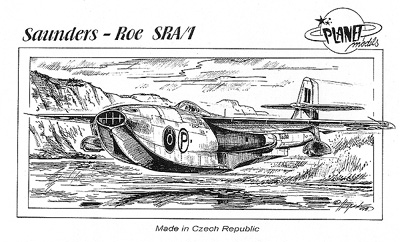
Planet Models 1/72 Saunders Roe SR/A.1
By Chris Banyai-Riepl
History
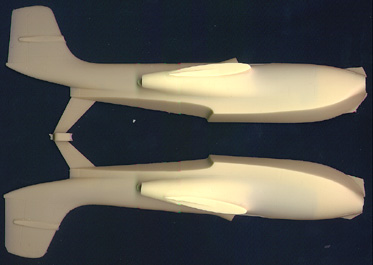 The yellow circle with a "P" in it has graced the sides of many strange looking aircraft, and the Saunders Roe SR/A.1 is definitely one of them. Designed in the closing stages of the Second World War, the SR/A.1 was intended to be used as a fighter in the Pacific, where air bases were few and far between. With a length of 50 feet, this was a big fighter, and three prototypes were made. The SR/A.1 had a short life span, only flying for about three years, with the last flight taking place in 1950.
The yellow circle with a "P" in it has graced the sides of many strange looking aircraft, and the Saunders Roe SR/A.1 is definitely one of them. Designed in the closing stages of the Second World War, the SR/A.1 was intended to be used as a fighter in the Pacific, where air bases were few and far between. With a length of 50 feet, this was a big fighter, and three prototypes were made. The SR/A.1 had a short life span, only flying for about three years, with the last flight taking place in 1950.
The Kit
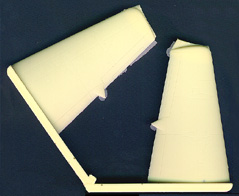 Planet Models has come out with a nice resin kit of this odd plane, and upon opening the box you have to keep telling yourself that this is in fact a 1/72 kit. It's about the same length as an F-4 or F-14, so plan your shelf space accordingly. The parts themselves are very finely molded, with no traces of air bubbles anywhere and minimal flash. Since the only marking choice for this plane is aluminum overall, the lack of air bubbles is very nice.
Planet Models has come out with a nice resin kit of this odd plane, and upon opening the box you have to keep telling yourself that this is in fact a 1/72 kit. It's about the same length as an F-4 or F-14, so plan your shelf space accordingly. The parts themselves are very finely molded, with no traces of air bubbles anywhere and minimal flash. Since the only marking choice for this plane is aluminum overall, the lack of air bubbles is very nice.
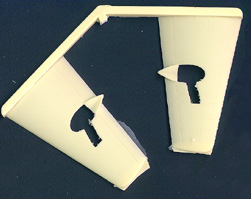 The kit is broken down into left and right fuselage halves and two piece wings, which is somewhat odd for a resin kit. Normally the wings are solid pieces. There is detail scribed into the underside of the upper wing half to depict the bay of the floatwell. The lower wings don't have any sidewalls, though, so you will have to build those up yourself.
The kit is broken down into left and right fuselage halves and two piece wings, which is somewhat odd for a resin kit. Normally the wings are solid pieces. There is detail scribed into the underside of the upper wing half to depict the bay of the floatwell. The lower wings don't have any sidewalls, though, so you will have to build those up yourself.
The cockpit is made up from a solid tub, an instrument panel, a seat, and a control column. The detail is sparse, but the canopy is small, and there isn't much to see anyway. There is room for enhancement, though, so if you have the references, go for it. Speaking of which, finding references for this kit is going to be a chore in and of itself. I was able to find only a bit here and a bit there, which will make superdetailing this one somewhat difficult.
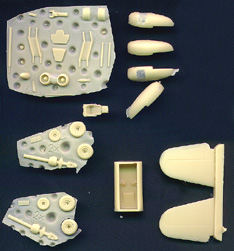 The wing floats are made up of four pieces, and look to be very well detailed when finished. If you don't fancy putting this big beast on the water, beaching gear is provided, with the two main struts and the tail wheel. I'm glad that this thing was a tail dragger, because you would have to put an awful lot of weight in this one if it had to sit on its nose.
The wing floats are made up of four pieces, and look to be very well detailed when finished. If you don't fancy putting this big beast on the water, beaching gear is provided, with the two main struts and the tail wheel. I'm glad that this thing was a tail dragger, because you would have to put an awful lot of weight in this one if it had to sit on its nose.
All of the detail parts are very well molded, and the detail on them is very crisp and clean. Once separated from the thin sheet surrounding them, they should clean up nicely and will need little more than some careful painting.
The decals are printed by Propagteam, and are almost up to their usual quality. However, on my sheet the roundels had the yellow out of register and the red center out of register, but only on those two roundels. The other ones were in register, which I find to be very odd. You would think that if the red was out of register, it would be out of register on all of them. All three SR/A.1s are given as decal choices, the only differences between them being the serial numbers. The decals are thin and look like they will snuggle down nicely.
Conclusion
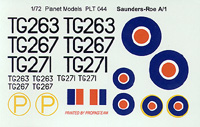 After looking at this kit in the box, I can't wait to start building it. Having a kit of this unique prototype is nice, and having a kit with this much detail and quality of molding is even better. If you want something to offset your shelves of Spitfires and Hurricanes, this kit would definitely provide some great contrast (and displace about 3 Spitfires in the process!).
After looking at this kit in the box, I can't wait to start building it. Having a kit of this unique prototype is nice, and having a kit with this much detail and quality of molding is even better. If you want something to offset your shelves of Spitfires and Hurricanes, this kit would definitely provide some great contrast (and displace about 3 Spitfires in the process!).
My thanks to Planet Models for providing the review sample.
 The yellow circle with a "P" in it has graced the sides of many strange looking aircraft, and the Saunders Roe SR/A.1 is definitely one of them. Designed in the closing stages of the Second World War, the SR/A.1 was intended to be used as a fighter in the Pacific, where air bases were few and far between. With a length of 50 feet, this was a big fighter, and three prototypes were made. The SR/A.1 had a short life span, only flying for about three years, with the last flight taking place in 1950.
The yellow circle with a "P" in it has graced the sides of many strange looking aircraft, and the Saunders Roe SR/A.1 is definitely one of them. Designed in the closing stages of the Second World War, the SR/A.1 was intended to be used as a fighter in the Pacific, where air bases were few and far between. With a length of 50 feet, this was a big fighter, and three prototypes were made. The SR/A.1 had a short life span, only flying for about three years, with the last flight taking place in 1950.The Kit
 Planet Models has come out with a nice resin kit of this odd plane, and upon opening the box you have to keep telling yourself that this is in fact a 1/72 kit. It's about the same length as an F-4 or F-14, so plan your shelf space accordingly. The parts themselves are very finely molded, with no traces of air bubbles anywhere and minimal flash. Since the only marking choice for this plane is aluminum overall, the lack of air bubbles is very nice.
Planet Models has come out with a nice resin kit of this odd plane, and upon opening the box you have to keep telling yourself that this is in fact a 1/72 kit. It's about the same length as an F-4 or F-14, so plan your shelf space accordingly. The parts themselves are very finely molded, with no traces of air bubbles anywhere and minimal flash. Since the only marking choice for this plane is aluminum overall, the lack of air bubbles is very nice. The kit is broken down into left and right fuselage halves and two piece wings, which is somewhat odd for a resin kit. Normally the wings are solid pieces. There is detail scribed into the underside of the upper wing half to depict the bay of the floatwell. The lower wings don't have any sidewalls, though, so you will have to build those up yourself.
The kit is broken down into left and right fuselage halves and two piece wings, which is somewhat odd for a resin kit. Normally the wings are solid pieces. There is detail scribed into the underside of the upper wing half to depict the bay of the floatwell. The lower wings don't have any sidewalls, though, so you will have to build those up yourself.The cockpit is made up from a solid tub, an instrument panel, a seat, and a control column. The detail is sparse, but the canopy is small, and there isn't much to see anyway. There is room for enhancement, though, so if you have the references, go for it. Speaking of which, finding references for this kit is going to be a chore in and of itself. I was able to find only a bit here and a bit there, which will make superdetailing this one somewhat difficult.
 The wing floats are made up of four pieces, and look to be very well detailed when finished. If you don't fancy putting this big beast on the water, beaching gear is provided, with the two main struts and the tail wheel. I'm glad that this thing was a tail dragger, because you would have to put an awful lot of weight in this one if it had to sit on its nose.
The wing floats are made up of four pieces, and look to be very well detailed when finished. If you don't fancy putting this big beast on the water, beaching gear is provided, with the two main struts and the tail wheel. I'm glad that this thing was a tail dragger, because you would have to put an awful lot of weight in this one if it had to sit on its nose.All of the detail parts are very well molded, and the detail on them is very crisp and clean. Once separated from the thin sheet surrounding them, they should clean up nicely and will need little more than some careful painting.
The decals are printed by Propagteam, and are almost up to their usual quality. However, on my sheet the roundels had the yellow out of register and the red center out of register, but only on those two roundels. The other ones were in register, which I find to be very odd. You would think that if the red was out of register, it would be out of register on all of them. All three SR/A.1s are given as decal choices, the only differences between them being the serial numbers. The decals are thin and look like they will snuggle down nicely.
Conclusion
 After looking at this kit in the box, I can't wait to start building it. Having a kit of this unique prototype is nice, and having a kit with this much detail and quality of molding is even better. If you want something to offset your shelves of Spitfires and Hurricanes, this kit would definitely provide some great contrast (and displace about 3 Spitfires in the process!).
After looking at this kit in the box, I can't wait to start building it. Having a kit of this unique prototype is nice, and having a kit with this much detail and quality of molding is even better. If you want something to offset your shelves of Spitfires and Hurricanes, this kit would definitely provide some great contrast (and displace about 3 Spitfires in the process!).My thanks to Planet Models for providing the review sample.
